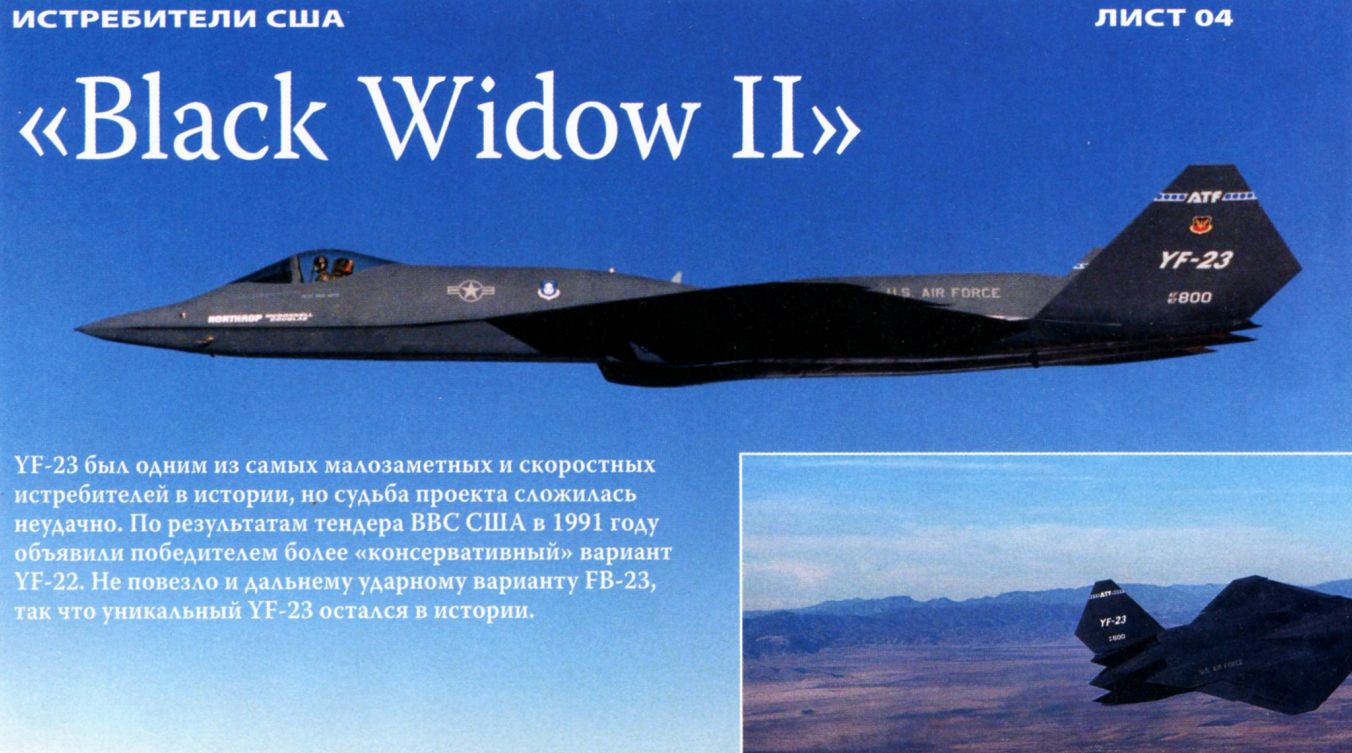
Варианты
- Boeing / Grumman / McDonnell Douglas / Rockwell - ATF - 1986 - США
- Lockheed - F-22 Raptor - 1990 - США
- Northrop - YF-23 - 1990 - США
Фотографии
-
Мировая Авиация 172
YF-23. 87-800 - первый опытный YF-23, ранее известный как PAV-1, - оснащался двигателем Pratt & Whitney YF119. Самолет проиграл конкурс на ATF, но двигатель - выиграл его.
-
Мировая Авиация 172
YF-23 был одним из самых малозаметных и скоростных истребителей в истории, но судьба проекта сложилась неудачно. По результатам тендера ВВС США в 1991 году объявили победителем более "консервативный" вариант YF-22. Не повезло и дальнему ударному варианту FB-23, так что уникальный YF-23 остался в истории.
-
Air International 1990-11 / Airscene
An in-flight view of the Northrop-McDonnell Douglas YF-23 on its maiden flight from Edwards AFB on 27 August 1990.
-
Мировая Авиация 172
Первый и второй опытный самолеты YF-23 в полете. Второй опытный самолет, 87-801, оснащался двумя двигателями General Electric YF120 - они были более мощными, чем YF119, и обеспечили второму YF-23 лучшие летные характеристики.
-
Air International 1994-12 / D.Baker - From ATF to Lightning II. A Bolt in Anger (1)
Both the side and plan elevations are graphically displayed in this view of the two YF-23A prototypes 87-0800 and 87-0801. The slender wing-blended fuselage is particularly worthy of note.
-
Air International 1994-12 / D.Baker - From ATF to Lightning II. A Bolt in Anger (1)
Northrop/McDonnell Douglas YF-23. Фирма "Northrop" полагала, что ключом к победе является высокая скорость и малозаметность. YF-23 в избытке обладал этими качествами - с двигателями General Electric YF120 он мог совершать крейсерский полет на скорости М=1,8 без использования форсажа.
Самолет имел в плане контуры, образованные прямыми линиями, - практически все они были параллельны передней или задней кромке крыла (исключая законцовки крыла и нижнюю переднюю часть фюзеляжа), а кромки всех створок и основных панелей обшивки имели зигзагообразную форму. Эти и другие решения позволили снизить заметность машины в радиолокационном диапазоне.
Seen in plan the YF-23A displays its unusual over-tail exhaust arrangement with a single serration for breaking radar returns. Note the small ailerons and large flaps, and parallel leading and trailing edges of wing and tail. -
Авиация и Космонавтика 2024-05 / М.Никольский - Рождение F-16 (2)
Самолет YF-23, созданный по программе ATF
-
Авиация и Космонавтика 2024-05 / М.Никольский - Рождение F-16 (2)
Northrop/McDonnell Douglas YF-23 поднялся в воздух 27 августа 1990 года - на месяц раньше YF-22. Сотрудничество "Northrop", лидера в области создания стелс-самолетов, и производителя лучшего на то время истребителя F-15 позволило создать уникальную машину.
-
Air International 1994-12 / D.Baker - From ATF to Lightning II. A Bolt in Anger (1)
Seen head-on, the YF-23 exhibits features first applied to the Lockheed SR-71, with chines from the front of the radome back to the wing leading edge.
-
Изд-во Schiffer / S.Markman & B.Holder - One-of-a-kind research aircraft
A strange new aircraft to serve as a testbed aircraft is one of the YF-23 prototype fighters which will be used in loads testing. It's shown here in its roll-out.
-
Air International 1994-12 / D.Baker - From ATF to Lightning II. A Bolt in Anger (1)
With trapezoidal underwing intakes and overwing engine-exhaust geometry, the YF-23A adopts multi/conipound-curvature to match low observable technology with an agile supercruise performance.
-
Air International 1994-12 / D.Baker - From ATF to Lightning II. A Bolt in Anger (1)
This view illustrates the smooth lines and high-set cockpit affording an excellent frontal view for the pilot.
-
Air International 1994-12 / D.Baker - From ATF to Lightning II. A Bolt in Anger (1)
Its length accentuated by the large overhanging tail surfaces, the Northrop-McDonnell Douglas YF-23A is rolled out to public view for the first time on June 22, 1990.
-
Мировая Авиация 172
Реактивные струи истекали из широких плоских сопел над плоской поверхностью (своеобразной "траншеей") между консолями оперения - такая конструкция способствовала быстрейшему охлаждению струи и снижению заметности самолета в инфракрасном диапазоне. Сопло конструктивно включало неподвижную нижнюю и подвижную верхнюю створки (последняя использовалась для регулирования площади проходного сечения сопла и для реверса тяги на посадке). Системы управления вектором тяги не было.
-
Air International 1994-12 / Airscene Headlines
Having lost the USAF ATF competition to the F-22, the two Northrop/McDonnell Douglas YF-23 prototypes, 87-0800 and 87-0801, have now been acquired by the NASA Dryden research facility at Edwards AFB. There are currently no plans to fly second prototype 87-0801, which is seen here in open storage at Dryden on October 6, 1994. The first example is, however, currently being worked on and will shortly join the NASA trials fleet. As an interesting aside, a mysterious night time accident in the UK at Boscombe Down, Wiltshire, on September 26 which was veiled in secrecy is rumoured to have involved an aircraft derived from the YF-23, indicating another previously unknown black programme.
-
Изд-во Schiffer / S.Markman & B.Holder - One-of-a-kind research aircraft
This photo shows the pair of YF-23 prototypes just after they were removed from storage. One of the craft would eventually be used to study strain gauge loads calibration techniques. The other, for the time being, will remain in storage.



















